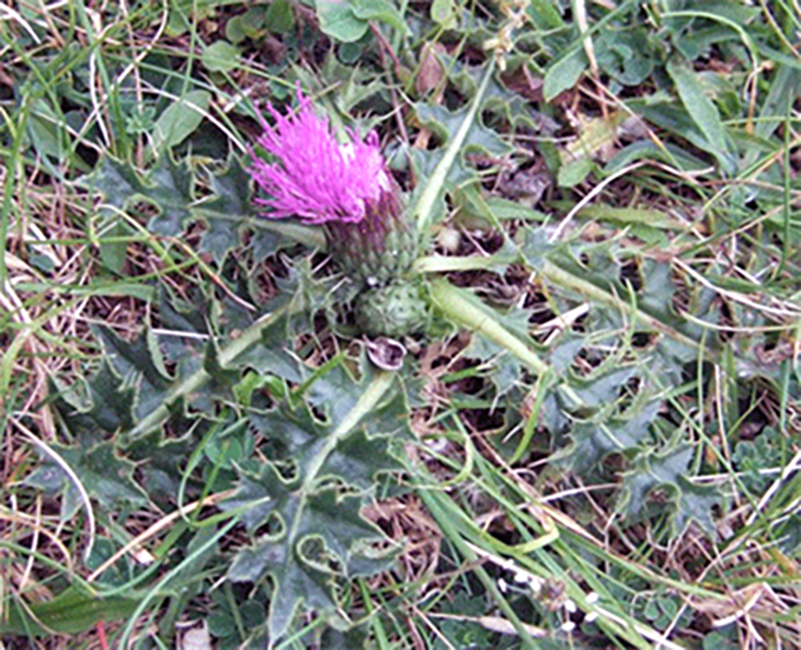 The image, above, shows the full dwarf thistle plant (Cirsium
The image, above, shows the full dwarf thistle plant (Cirsiumacaulon) in flower, showin the prostrate nature of its
leaves..
| Common Name: Dwarf Thistle |
| Scientific Name: Cirsium acaulon |
| Other Names: Stemless Thistle, Cirsium acaule, Dwarf Plume and Picnic Thistle |
| Family: Asteraceae |
| Range: Europe, including Britain, from Scandanavia to Spain and east to W. Asia. |
Physical Asteraceae Cirsium acaulon is a hardy Perennial plant, growing to 30cm (1 ft) by 60cm (2 ft) in size. It is hardy to zone 4 and is not frost tender. The plant flowers between July and September and its seeds ripen from August to October. The flowers are hermaphrodite and are pollinated by bees, flies and lepidoptera. The plant also self-fertilizes.
Cirsium acaulon is a hardy Perennial plant, growing to 30cm (1 ft) by 60cm (2 ft) in size. It is hardy to zone 4 and is not frost tender. The plant flowers between July and September and its seeds ripen from August to October. The flowers are hermaphrodite and are pollinated by bees, flies and lepidoptera. The plant also self-fertilizes.
|
| Edible Parts: Leaves |
|
|
|
|
Welcome to the summary page for FabulousFusionFood's Wild Food guide to Dwarf Thistle along with all the Dwarf Thistle containing recipes presented on this site, with 0 recipes in total.
This is a continuation of an entire series of pages that will, I hope, allow my visitors to better navigate this site. As well as displaying recipes by name, country and region of origin I am now planning a whole series of pages where recipes can be located by meal type and main ingredient. This page gives a listing of all the Cornish recipes added to this site.
These recipes, all contain Dwarf Thistle as a major wild food ingredient.
Dwarf thistle, (also known as Stemless Thistle, Dwarf Plume and Picnic Thistle) Cirsium acaulon is a member of the Asteraceae (daisy) family and is a perennial herbaceous plant that has a prostrate aspect and rarely bears stems more than 15cm tall. The leaves are spiny, undulate, oblong to oblong-lanceolate, pinnatisect; segments ovate to suborbicular, with 2-5 spinose-detate lobes. It is a native of Europe, with a range extending From Northern England and Estonia southwards to Southern Spain, Central Yugoslavia and South-eastern Russia.
Of the various thistle species, dwarf thistle is the most tractable as though the leaves are spiny they are covered in far fewer spines and burrs that most other thistles. To prepare, remove the mid-ribs from the leaves, scrape to strip any burrs then either boil or stir-fry.
[2]. Huxley, A. The New RHS Dictionary of Gardening. 1992
[3]. Tanaka, T. Tanaka's Cyclopaedia of Edible Plants of the World.
[4]. Lim T.K. Edible Medicinal And Non-Medicinal Plants, Vols 1–8.
[5]. Thomas, G. S. Perennial Garden Plants
[6]. Milner, E. Trees of Britain and Ireland
[7]. Rose, F. & O'Reilly, C. The Wild Flower Key (Revised Edition) – How to identify wild plants, trees and shrubs in Britain and Ireland
[8]. Streeter, D. & Garrard, I. The Wild Flowers of the British Isles
[9]. Clapham, A.R.; Tutin, T.G. & Moore, D.M. Flora of the British Isles
[10]. Phillips, R. Mushrooms
[10]. Phillips, R. Mushrooms
[11]. Jordan, P. & Wheeler, S. The Complete Book of Mushrooms: An Illustrated Encyclopedia of Edible Mushrooms
[12]. Bunker, F.; Brodie, J.A.; Maggs, C.A. & Bunker, A. Seaweeds of Britain and Ireland.
[13]. Facciola, S. Cornucopia — A Source Book of Edible Plants
This is a continuation of an entire series of pages that will, I hope, allow my visitors to better navigate this site. As well as displaying recipes by name, country and region of origin I am now planning a whole series of pages where recipes can be located by meal type and main ingredient. This page gives a listing of all the Cornish recipes added to this site.
These recipes, all contain Dwarf Thistle as a major wild food ingredient.
Dwarf thistle, (also known as Stemless Thistle, Dwarf Plume and Picnic Thistle) Cirsium acaulon is a member of the Asteraceae (daisy) family and is a perennial herbaceous plant that has a prostrate aspect and rarely bears stems more than 15cm tall. The leaves are spiny, undulate, oblong to oblong-lanceolate, pinnatisect; segments ovate to suborbicular, with 2-5 spinose-detate lobes. It is a native of Europe, with a range extending From Northern England and Estonia southwards to Southern Spain, Central Yugoslavia and South-eastern Russia.
Of the various thistle species, dwarf thistle is the most tractable as though the leaves are spiny they are covered in far fewer spines and burrs that most other thistles. To prepare, remove the mid-ribs from the leaves, scrape to strip any burrs then either boil or stir-fry.
References:
[1]. David Evans Notes from field observations, tastings and cookery experiments.[2]. Huxley, A. The New RHS Dictionary of Gardening. 1992
[3]. Tanaka, T. Tanaka's Cyclopaedia of Edible Plants of the World.
[4]. Lim T.K. Edible Medicinal And Non-Medicinal Plants, Vols 1–8.
[5]. Thomas, G. S. Perennial Garden Plants
[6]. Milner, E. Trees of Britain and Ireland
[7]. Rose, F. & O'Reilly, C. The Wild Flower Key (Revised Edition) – How to identify wild plants, trees and shrubs in Britain and Ireland
[8]. Streeter, D. & Garrard, I. The Wild Flowers of the British Isles
[9]. Clapham, A.R.; Tutin, T.G. & Moore, D.M. Flora of the British Isles
[10]. Phillips, R. Mushrooms
[10]. Phillips, R. Mushrooms
[11]. Jordan, P. & Wheeler, S. The Complete Book of Mushrooms: An Illustrated Encyclopedia of Edible Mushrooms
[12]. Bunker, F.; Brodie, J.A.; Maggs, C.A. & Bunker, A. Seaweeds of Britain and Ireland.
[13]. Facciola, S. Cornucopia — A Source Book of Edible Plants
The alphabetical list of all Dwarf Thistle recipes on this site follows, (limited to 100 recipes per page). There are 0 recipes in total:
Page 1 of 1
Page 1 of 1